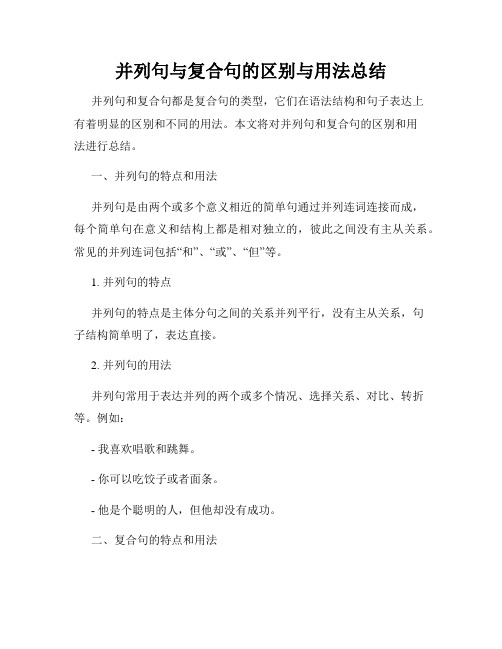并列句和复合句的区别-并列句和复合句
并列句与复合句的区别与用法总结

并列句与复合句的区别与用法总结并列句和复合句都是复合句的类型,它们在语法结构和句子表达上有着明显的区别和不同的用法。
本文将对并列句和复合句的区别和用法进行总结。
一、并列句的特点和用法并列句是由两个或多个意义相近的简单句通过并列连词连接而成,每个简单句在意义和结构上都是相对独立的,彼此之间没有主从关系。
常见的并列连词包括“和”、“或”、“但”等。
1. 并列句的特点并列句的特点是主体分句之间的关系并列平行,没有主从关系,句子结构简单明了,表达直接。
2. 并列句的用法并列句常用于表达并列的两个或多个情况、选择关系、对比、转折等。
例如:- 我喜欢唱歌和跳舞。
- 你可以吃饺子或者面条。
- 他是个聪明的人,但他却没有成功。
二、复合句的特点和用法复合句是由一个主句和一个或多个从句组成,从句在逻辑上对主句起修饰、说明、列举、解释、原因等作用。
常见的复合句包括主从复合句和连词复合句。
1. 复合句的特点复合句的特点是由主句和从句构成,主句在句子中起主导作用,从句侧重于对主句的补充或说明,从属于主句。
2. 复合句的用法复合句常用于表示因果关系、时间关系、条件关系、目的关系等。
例如:- 因果关系:由于下雨,所以我没有去上学。
- 时间关系:明天我会去图书馆,看看新买的书。
- 条件关系:如果你努力学习,你会取得好成绩。
三、并列句和复合句的区别并列句和复合句的区别主要在于句子结构和从属关系的不同。
1. 句子结构并列句是由多个简单句通过并列连词相连而成,每个简单句在结构上是相对独立的。
复合句是由主句和从句构成,从句在结构上依赖于主句。
2. 从属关系并列句中的分句没有主从关系,彼此之间是平行并列的关系,对句子的理解和分析不依赖于其他分句。
复合句中的从句依赖于主句,从属于主句,从句的意义和表达依赖于主句的引导。
总结:并列句和复合句是常见的复合句类型,它们在句子结构和从属关系上有明显的区别。
并列句是由简单句通过并列连词连接而成,结构简单明了,句子主从关系平行并列;复合句是由主句和从句构成,主句主导从句,句子主从关系明显。
英语中的并列句和复合句的区别

英语中的并列句和复合句的区别
并列句和复合句是英语语法中两种不同类型的句子结构。
1. 并列句:
-定义:并列句由两个或更多相互关联的独立子句组成,每个子句都有自己的主语和谓语,并用逗号、分号或连词将它们连接在一起。
-结构:并列句中的子句之间是平等的,没有主次之分,各个子句并列起来,相互独立。
-示例:I like to play tennis, and my brother likes to play soccer.(我喜欢打网球,我哥喜欢踢足球。
)
2. 复合句:
-定义:复合句由一个主句和一个或多个从句构成,从句是一个包含主语和谓语的从属结构,不能独立成句。
-结构:复合句中的从句是主句的一部分,从句依附于主句,起到修饰、补充或说明主句意思的作用。
-示例:She went to the supermarket after she finished work.(她工作完成后去了超市。
)
区别:
-结构:并列句中的子句是相互独立的,各自有自己的主谓结构,而复合句中的从句是主句的一部分,不能独立成句。
-逻辑关系:在并列句中,各个子句之间是并列关系,表达的是并列的事实或观点。
而复合句中的从句是主句的修饰、补充或说明,表达的是主次关系或因果关系。
-连接词:在并列句中,子句之间使用逗号、分号或连词(如and、but等)连接;而复合句中,使用从属连词(如when、because、although 等)连接主句和从句。
总之,通过并列句和复合句的不同结构和逻辑关系,可以更准确地表达复杂的思想和句意。
并列句与复合句的区别

并列句与复合句的区别在英语语法中,句子是构建语言的基本单位。
句子的结构可以通过不同类型的句子来体现。
其中,最常用的两种句子类型是并列句和复合句。
尽管它们都由多个部分组成,但它们之间存在着明显的区别。
本文将探讨并列句和复合句的区别,并比较它们在句法结构、意义传达以及语言表达上的异同。
一、句法结构1. 并列句:并列句是由两个或更多个具有相同地位的独立分句组成的。
这些分句之间通常通过逗号(,)或连词(如and、or、but等)连接。
并列句的结构如下所示:[独立分句1] [连词/逗号] [独立分句2]例如:- I like playing football, and my brother enjoys swimming.(我喜欢踢足球,而我弟弟喜欢游泳。
)- She is intelligent, hardworking, and dedicated.(她聪明、努力且专注。
)2. 复合句:复合句由一个主句和一个或多个从句组成。
从句可以是名词从句、形容词从句或副词从句。
它们与主句之间有一种从属关系,从而构成复杂的句子结构。
复合句的结构如下所示:[主句] + [从句]例如:- He said that he would come tomorrow.(他说他明天会来。
)- When it rains, I stay indoors.(下雨时,我待在室内。
)二、意义传达1. 并列句:并列句通常将两个或多个独立但相关的思想并列在一起,彼此之间没有逻辑上的从属关系。
它们之间以并列的方式并存,用于传达相同等级的信息或者表示句子之间的转折、选择等关系。
并列句常用于列举或对比相关事物,以及表达并列的行为、状态或性质。
例如:- Cats are independent, but dogs are more loyal to their owners.(猫很独立,但狗对主人更忠诚。
)- I like to travel, swim, and read books.(我喜欢旅行、游泳和读书。
并列句和复合句的区别和连接词的使用

并列句和复合句的区别和连接词的使用并列句和复合句的区别与连接词的使用句子是语言表达的基本单位,而在句子的构建中,使用并列句和复合句可以让句子更加丰富和灵活。
本文将介绍并列句和复合句的区别,并详细解析连接词在复合句中的使用。
一、并列句的定义和特点并列句是由两个或多个相对独立的简单句构成,并以逗号、分号或连词来连接。
并列句的特点是句子间缺乏因果、时间或逻辑上的联系,主要是同时表述多个相对独立的信息。
例如:1. 我喜欢吃苹果,他喜欢吃橘子。
2. 她唱歌动听,跳舞优美,非常有才华。
3. 他努力学习,积极参加社会实践活动,为将来做好准备。
从上面的例句可以看出,不同的简单句在并列结构下并无因果或逻辑关系,并列句中的信息相对独立。
二、复合句的定义和特点复合句是由一个主句和一个或多个从句构成的句子。
主句是句子的核心部分,从句对主句进行修饰、补充或解释,两者之间存在一定的逻辑关系。
例如:1. 我希望你能来参加我的生日派对,因为我们是好朋友。
(原因关系)2. 尽管下雨了,他仍然坚持出门跑步。
(让步关系)3. 我正在看一本书,这本书很有趣。
(并列关系)从上面的例句可以看出,复合句中的主句和从句之间往往存在因果、让步、并列等逻辑关系,从句对主句进行修饰和补充。
三、连接词的使用连接词在并列句和复合句中起到连接句子成分的作用。
在并列句中,常用的连接词有逗号、分号、连词等;在复合句中,常用的连接词有连词、关系代词、关系副词等。
1. 并列句中连接词的使用在并列句中,逗号用于连接两个简单句,表达相对独立的信息。
例如:“他喜欢看书,我喜欢听音乐。
”分号用于连接两个独立但相关的分句。
例如:“今天天气晴朗;我们决定去郊游。
”并列连词如"和"、"或"、"但"等也常用于连接两个简单句。
例如:“他喜欢跑步和篮球。
”值得注意的是,并列句中的逗号和分号前后需要有配对。
2. 复合句中连接词的使用在复合句中,连词的使用相对复杂。
并列句与复合句的区别及用法

并列句与复合句的区别及用法在英语写作中,我们经常使用并列句和复合句来丰富句子结构,增强表达效果。
并列句和复合句在句子的组织和信息表达上有着不同的特点和用法。
本文将详细介绍并列句与复合句的区别,并探讨它们在写作中的常见用法。
一、并列句并列句是由两个或多个主观并列的句子组成的。
这些句子在逻辑上平等,彼此之间没有从属关系。
并列句的主要特点是句子之间使用逗号、分号或连词(如and、but、or等)来连接。
并列句通常用于表达出列举、对比、选择等关系。
1. 列举:当我们想要表达多个事物、观点或行动时,我们可以使用并列句来进行列举。
例如:I like swimming, hiking, and playing basketball.2. 对比:并列句也可以用来表达对比关系,表示两个相互独立但相对的事物或观点。
例如:She is hardworking, but her brother is lazy.3. 选择:有时我们需要在两个或多个选项之间进行选择,此时并列句可以派上用场。
例如:You can either go to the party or stay at home and watch a movie.在使用并列句时,我们需要注意句子之间的平衡性和逻辑关系,以确保句子结构紧凑、顺畅。
二、复合句复合句由一个主句和一个或多个从句(即依存从句)组成。
从句在句子中充当某个成分(如主语、宾语、状语等),并且与主句之间存在从属关系。
复合句的主要特点是使用诸如关联词(如that, which, who, when, where, why等)或连词(如although, because, while, and等)来引导从句。
1. 名词性从句:复合句中的名词性从句可以作为主语、宾语、表语等。
例如:What he said made me happy.(主语从句)I believe that he is innocent.(宾语从句)The fact is that he is the best candidate for the job.(表语从句)2. 定语从句:复合句中的定语从句用于修饰一个名词或代词。
句子结构并列句与复合句的区别与用法

句子结构并列句与复合句的区别与用法句子结构:并列句与复合句的区别与用法句子是语言表达的基本单位,而句子的结构是语法学中重要的一部分。
在句子结构中,人们常常会遇到并列句和复合句,它们在构造和用法上有很大的差异。
本文将着重探讨并列句和复合句的区别,并介绍它们的常见用法。
一、并列句的定义和用法1. 并列句的定义并列句是由两个或更多的简单句构成的句子,这些句子之间的关系是平行的,彼此之间没有主从关系。
并列句的常见连接词有“和”、“或”、“但”等。
2. 并列句的结构和特点并列句的结构较为简单,句子之间通过逗号、顿号或分号等标点符号进行连接。
并列句中,每个句子都是完整的,都有自己的主语和谓语。
并列句表达的是两个或多个句子之间的并列关系,句子之间的逻辑联系较为松散。
3. 并列句的用法并列句常常用于以下几种情况:(1) 表示并列关系:她喜欢唱歌,也喜欢跳舞。
(2) 表示选择关系:你可以坐火车,也可以坐飞机。
(3) 表示转折关系:他努力学习,但成绩并不理想。
二、复合句的定义和用法1. 复合句的定义复合句是由两个或更多的分句构成的句子,其中一个分句是主句,它承担着整个句子的核心意义;其他分句是从句,依附于主句,起到修饰或者补充主句的作用。
2. 复合句的结构和特点复合句的结构相对较复杂,包含一个主句和一个或多个从句。
主句是复合句的核心部分,从句相对而言较为次要。
在复合句中,主从句之间通过连接词或引导词进行连接,起到衔接句子的作用。
3. 复合句的用法复合句常常用于以下几种情况:(1) 表示因果关系:因为下雨,所以比赛取消了。
(2) 表示条件关系:如果你愿意,我可以帮助你。
(3) 表示时间关系:当我看到她的时候,她正在忙着工作。
三、并列句与复合句的区别1. 句子结构的差异并列句由两个或多个简单句构成,每个简单句都是完整的,都有自己的主语和谓语。
而复合句由一个主句和一个或多个从句构成,主句是句子的核心部分,从句依附于主句。
并列句与复合句区别
并列句与复合句区别在英语语法中,句子的结构可以分为简单句、并列句和复合句。
并列句和复合句是两种常见的句子结构,它们在表达方式和句子结构上存在一些明显的区别。
本文将对并列句和复合句的区别进行详细讨论。
一、并列句的特点并列句是由两个或多个主句(亦称为并列分句)组成的句子。
每个主句具有相同的地位,它们彼此之间通过连词而连接起来。
常见的并列连词有"and"、"but"、"or"、"so"等。
以下是几个示例:1. I like to read books, and my sister likes to watch movies.2. He is intelligent, but he is not hardworking.3. You can choose to study abroad, or you can find a job in your hometown.在这些例子中,每个主句都可以独立成为一个完整的句子,它们并列在一起,通过逗号和连词连接。
并列句的特点是各个主句之间的关系是相对平行和对等的。
每个主句内部的结构可以是简单句、复合句或其他类型的句子结构。
并列句的优点是简洁明了,易于理解和表达。
二、复合句的特点复合句是由一个主句和一个或多个从句(亦称为主从句或附属句)组成的句子。
主从句之间存在一种依存关系,从句一般起到修饰、补充或解释主句的作用。
从句可以是名词从句、形容词从句或副词从句。
以下是几个示例:1. I will help you if you need any assistance.2. She is happy because she passed the exam.3. He bought a new car, which is very expensive.在这些例子中,从句不能单独成为一个完整的句子,它们依托于主句的结构存在。
并列句和复合句的区别与组成
并列句和复合句的区别与组成并列句和复合句是英语语法中两种常见的句子结构,它们在句子的构成和表达方式上有着明显的差别。
本文将探讨并列句和复合句的区别以及它们各自的组成形式。
一、并列句的特点和组成方式并列句是由两个或更多个具有相同地位的独立子句构成的句子。
每个独立子句之间用连词(如and, or, but, so等)连接。
并列句中的各个子句之间是平行关系,没有主从之分。
例如:1. I like to read books, and my sister likes to watch movies.我喜欢读书,而我妹妹喜欢看电影。
2. He is not only a talented musician but also a great writer.他不仅是一个有才华的音乐家,而且还是一位伟大的作家。
可以看出,在这些例子中,每个子句都可以独立成为一个完整的句子,通过并列的方式连接在一起,表达两个或多个相互独立但相关的意思。
二、复合句的特点和组成方式复合句由一个主句和一个或多个从句组成。
主句是一个完整的句子,而从句(包括名词性从句、形容词性从句和副词性从句)则不能独立存在,需要依附于主句才能完成意义的表达。
例如:1. She is studying English because she wants to go abroad.她正在学习英语,因为她想出国。
2. I will go shopping after I finish my work.我一完成工作就去购物。
可以看出,在这些例子中,从句(because she wants to go abroad和after I finish my work)不能独立成句,它们是依附于主句(She is studying English和I will go shopping)而存在的。
三、并列句和复合句的区别1. 句子结构:并列句由并列的独立子句构成,而复合句由主句和从句构成。
并列句与复合句的区别与构成
并列句与复合句的区别与构成一、区别与定义并列句(Compound Sentences)和复合句(Complex Sentences)是英语中常用的两种句子结构。
它们分别由两个或更多个分句组成,但在结构和功能上有所不同。
并列句由两个或多个独立分句并列连接而成,使用并列连词(如and、but、or等)将这些分句连接在一起。
这些独立分句之间意思相对独立,没有从属关系,只是并列关系。
复合句由一个主句和一个或多个从句组成,从句可以是名词性从句、形容词性从句或副词性从句。
主句与从句之间有着属于关系,从句为主句提供了更多的信息。
二、构成方式1. 并列句的构成方式并列句可以通过以下方式构成:a) 使用并列连词连接两个独立分句,如:- I like playing basketball, and he prefers swimming.(我喜欢打篮球,而他更喜欢游泳。
)b) 使用分号(;)分隔两个独立分句,如:- She is studying in the library; he is playing football in the park.(她正在图书馆学习,他在公园踢足球。
)c) 使用破折号(—)或冒号(:)分隔两个独立分句,如:- The sun rises—birds start singing in the morning.(太阳升起时,鸟儿开始在清晨歌唱。
)- She brought many things with her: clothes, books, and a laptop.(她带了很多东西:衣服、书籍和一台笔记本电脑。
)2. 复合句的构成方式复合句可以通过以下方式构成:a) 使用连接词引导从句,连接词包括连词、关系代词和关系副词等,如:- I will go to the supermarket after I finish my work.(我完成工作后会去超市。
)- This is the book that I bought yesterday.(这是我昨天购买的那本书。
并列句和复合句的区别
并列句和复合句的区别句子作为语言表达的基本单位,在表达能力和语法结构上有多种形式。
并列句和复合句是两种常见的句子结构形式,在语言表达上有着显著的区别。
本文将从结构、功能和使用等方面详细探讨并列句和复合句的区别。
一、结构上的区别并列句由两个或多个结构相同的简单句通过连接词(如“和”、“或”、“但”等)连接起来,形成具有并列关系的句子。
各个简单句在结构上保持独立,彼此之间没有从属关系。
复合句由一个主句和一个或多个从句组成。
主句是句子的核心部分,从句是主句的修饰或补充,从属于主句的结构形式。
从属连词(如“因为”、“尽管”、“当...时候”等)引导从句与主句连接,使整个句子变得复合。
二、功能上的区别并列句主要用来表示两个或多个平行、对等的事物、概念、事件或观点等之间的关系。
并列句可以用于并列并列的并列关系,也可以用于递进、转折、选择等语义关系。
复合句则主要用于表达主句与从句之间的依存或因果关系。
从句在语义上对主句起到修饰、补充、陈述理由或条件等作用。
复合句使得句子的表达更加丰富、准确。
三、使用上的区别并列句可以用在描述并列的事物、观点、事件等之间的关系上。
如:1. 我喜欢唱歌和跳舞。
(并列的兴趣爱好)2. 他既懂英语又会法语。
(并列的语言能力)并列句还可以用于表达递进、转折、选择等关系。
如:1. 他努力学习,但成绩并不理想。
(转折关系)2. 昨天他去了图书馆,或者去了电影院。
(选择关系)复合句则可以用在表达因果、条件、时间、原因等关系上。
如:1. 因为下雨,所以我们取消了郊游计划。
(原因关系)2. 如果你有时间,请尽快回复我。
(条件关系)3. 昨天我看到了一个老朋友,他告诉我他要搬去另一个城市。
(时间和原因关系)综上所述,并列句和复合句在结构、功能和使用上存在明显的差异。
了解并正确应用这两种句子结构,不仅能够提升语言表达的能力,还能够使句子更加丰富和准确。
不管是在口语还是写作中,合理运用并列句和复合句将为我们的语言表达增添魅力和表现力。
- 1、下载文档前请自行甄别文档内容的完整性,平台不提供额外的编辑、内容补充、找答案等附加服务。
- 2、"仅部分预览"的文档,不可在线预览部分如存在完整性等问题,可反馈申请退款(可完整预览的文档不适用该条件!)。
- 3、如文档侵犯您的权益,请联系客服反馈,我们会尽快为您处理(人工客服工作时间:9:00-18:30)。
并列句和复合句的区别|并列句和复合句
并列句和复合句
并列句
两个或两个以上独立的主谓结构或简单句并列在一起,我们称之为并列句。
各个简单句间是平行并列的关系,而非从属关系。
并列句的各个分句间可用逗号、分号、起连接作用的副词或并列连接词来连接。
1. 能连接并列句的连词
and(和,又),but(但是),for(因为),however(然而),
or(或者),so(所以,因而),while(然而),yet(然而)
2. 能连接并列句的复合连词
or else(否则,要不然),either...or...(要么···,要么···;或者···,或者···),neither...nor...(既不···,也不···),not only...but also(不仅···,而且···)
3. 能连接并列句的副词
besides(而且,还有),hence(因此),otherwise(否则,要不然),then(然后,于是),therefore(因此,所以),thus(因而,从而)
复合句
一个句子,如果有一个或多个成分由句子充当,并列句和复合句则它就是复合句。
其中能够独立存在的句子,称之为主句,主句也是全句的主体;而充当全句的一个句子成分的句子,则称之为从句,从句不能独立存在。
因此,我们也把这种存在主从关系的复合句,叫做主从复合句。
主从复合句可以分为如下三类:
1. 名词性从句
名词性从句,按照句子在全句中充当的句子成分,又分为:
1)主语从句
2)宾语从句
3)表语从句
4)同位语从句
2. 定语从句
定语从句须由关系代词或关系副词来连接。
3. 状语从句
状语从句又可分为:
1)时间状语从句
2)地点状语从句
3)原因状语从句
4)条件状语从句
5)目的状语从句
6)结果状语从句
7)方式状语从句
8)让步状语从句
9)比较状语从句
并列句复合句
1、也美丽半命题作文议论文并列式(20XX-06-24)
2、供电局党员对照“两学一做”查摆自身存在的问题,并列出问题清单和整改清单(20XX-07-05)
3、幸福无处不在作文并列式结构600字(20XX-09-08)
4、成功在于专业并列试作文(20XX-09-29)
5、并列式作文温暖荡漾在心头(20XX-03-07)。
